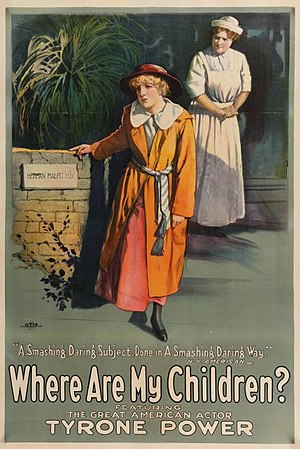Where Are My Children?
Jump to navigation
Jump to search
| This article was copied (instead of imported) from the now-deleted Miraheze wikis. |
| Where Are My Children? | ||||||||||||||||||||||
|---|---|---|---|---|---|---|---|---|---|---|---|---|---|---|---|---|---|---|---|---|---|---|
This film has been preserved in the National Film Registry in 1993.
| ||||||||||||||||||||||
 | ||||||||||||||||||||||
|
Where Are My Children? is a 1916 American silent drama film directed by Phillips Smalley and Lois Weber and stars Tyrone Power Sr., Juan de la Cruz, Helen Riaume, Marie Walcamp, Cora Drew, A.D. Blake, Rene Rogers, William Haben and C. Norman Hammond.
The film tells the story of a district attorney (Power Sr.) who, while prosecuting a doctor for illegal abortions, finds out that society people, including his wife, used the doctor's services.
Why It Rocks
- Although Lois Weber's style for a dramatization of the moral and legal dilemmas associated with contraception and abortion may appear heavy-handed and stilted by modern standards, she still created a thought-provoking film that forthrightly addresses an assortment of taboo subjects that rankled censors back in the mid-1910s. It was even one of the first films to address these issues, although it does bare a lot of similarities to a similar scenario with Margaret Sanger.
- The film makes a eugenicist argument in favor of birth control for working-class and immigrant families, while lambasting privileged white women for not “bettering” the race, vilifying them further through their association with abortion, rather than contraception. As several reviewers pointed out at the time, this material was unlike family planning practices of the day, for it was impoverished women, less likely to have access to adequate contraception, who were often forced to rely on unsafe abortions, while their wealthier counterparts practiced safe and effective family planning with tacit help from the medical establishment.
- While "message dramas" about birth control were fairly common in the evolution of silent film -- especially with Margaret Sanger stepping up her campaign to legalize contraception -- along with women directors and writers, Weber was among the most popular and commercially astute. This is one of the many films she made on key social issues in the mid-1910s, including addiction, poverty, and the fight to abolish capital punishment. She could deal successfully with subjects which other directors would not dare to touch for fear of condemnation.
- This film is honest and straightforward about its subject matter as films wouldn't be this open about abortion again for another couple decades. This also makes the film very ahead of its time. Weber didn't concentrate on salacious details, but on the human costs of betrayed relationships, something that even some modern filmmakers still find uncomfortable.
- As the film interweaves the multiple story lines through patterns of crosscutting, the film makes clear that while men legislate reproductive issues in public courtrooms, women, excluded from these debates, carry on clandestine conversations in private.
- The film’s message about sexuality, reproduction and contraception is further clouded by a subplot involving the housekeeper’s daughter Lillian who gets lured into a liaison with Edith’s Lothario brother Roger. Lillian becomes pregnant – “the wages of sin,” a title informs us – and ultimately dies from an unsafe abortion she procures with Edith’s help. Lillian’s narrative adds another dimension to the film’s portrayal of unplanned pregnancy and complicates its overlay of abortion and contraception.
- The film does not go so far as to promote reproductive freedom for consenting, unmarried adults, a case Margaret Sanger was indeed making in the 1910s, but Lillian’s subplot introduces the topic of sexuality outside reproduction, albeit with a rather clichéd tale of a male predator and his gullible victim.
Bad Qualities
- One of the film's major issues is that it tends to send a mixed and/or confusing message, especially since certain stories elements couldn't be spelled out in fear of censorship. As a result, a lot of the imagery is very difficult to decipher.
- Another big issue is how Weber's technique was trapped in a heavily declamatory style of staging, which is probably a throwback to her street-corner sermonizing. She does little more than place characters within settings, where they portray the most basic emotions, without nuance or ambiguity, or even much of a chance to interact with each other.
Trivia
- Where Are My Children? is the first female-directed silent-era film (Lois Weber in this case) to be inducted into the National Film Registry.